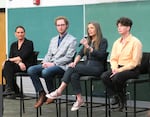
Roughly 200 people gathered inside the UO's Prince Lucien Campbell Hall on the night of April 10, 2025. Panelists discussed the role CAHOOTS has in the community, and how they might be able to become operational again in Eugene.
Brian Bull
The mobile crisis intervention service CAHOOTS is essential and needs to be continued. That was the message from those who attended Thursday night’s town hall meeting held at the University of Oregon, following the elimination of CAHOOTS services in Eugene earlier in the week.
Presenters — including former and current CAHOOTS employees — told the audience how the Eugene community benefits from the work they do on the streets. This included de-escalating situations that could warrant use of force by police, or ending up with someone being taken to a hospital.

Panelists for the town hall were (from L to R): CAHOOTS worker Michelle Perin, UO Class of 2024 data science researcher Nathan Burton, CAHOOTS worker Laurel Lisovskis, and White Bird employee Alese Dandy Colehour.
Brian Bull
Alese Dandy Colehour had been working with CAHOOTS until recently, but is now with White Bird Clinic — the nonprofit that operates CAHOOTS. Before the crowd of roughly 200 people, Colehour presented a community survey done in conjunction with Portland State University.
“Ninety-four percent of respondents supported CAHOOTS being paid with tax dollars,” Colehour said. “So we want to hold the cities accountable to that.”
Other findings in the PSU study showed that in 2024, CAHOOTS handled over 16,800 calls for service, which breaks down to an average of 46 calls per day. Those numbers include Springfield, where service continues to operate.
During the Q&A period, which concluded the town hall, many in the audience posed questions on how to fund CAHOOTS to the point that it can resume Eugene operations. Colehour said they hope to explore options with city officials soon.
“CAHOOTS definitely needs to diversify our funding in order to keep our wheels on the road,” Colehour said. ”We live in a pretty politically complex climate right now. We can’t blame any one entity for what’s happened, and we need to all come together as a community to solve it.”

Associate Professor Rori Rohlfs of the UO's School of Computer and Data Sciences, served as moderator for the town hall event.
Brian Bull
Several CAHOOTS workers told the audience that if the City of Eugene could match the reimbursement rate in their Springfield contract, CAHOOTS could go back to operating 24/7. Currently, the CAHOOTS reimbursement rate under the City of Eugene’s contract covers 40% of the program’s operating costs, compared to 100% through the City of Springfield.
The PSU study’s executive summary says CAHOOTS is also seeking to diversify funding opportunities by obtaining licensure with Oregon Health Authority to offer billable behavioral health services.
“But behavioral health is only one aspect of what CAHOOTS does,” adds the summary. “CAHOOTS also offers essential public safety services such as welfare checks, traffic hazards, transportation, and housing crises that are not covered in the scope of behavioral health.”
Many members of the audience openly called for a show of support at the next City Council meeting in Eugene next week. Panelists invited supporters to also follow their social media accounts for more developments.
CAHOOTS services are still available in Springfield from 11 a.m. -11 p.m. daily, while the White Bird’s crisis line is available from 8 a.m. -8 p.m. on weekdays.

In this 2019 photo, a CAHOOTS medic approaches the iconic white vans that make up the organization's fleet of mobile response vehicles.
Brian Bull
Launched in 1989, CAHOOTS — which means Crisis Assistance Helping Out On The Streets — began in Eugene as a partnership between Eugene Police and mental health/medical workers at the White Bird Clinic. In the decades since, the program’s been heralded as an effective model and has been replicated in numerous cities, including Denver and Oakland.
Brian Bull is a reporter with KLCC. This story comes to you from the Northwest News Network, a collaboration between public media organizations in Oregon and Washington.
It is part of OPB’s broader effort to ensure that everyone in our region has access to quality journalism that informs, entertains and enriches their lives. To learn more, visit our journalism partnerships page.